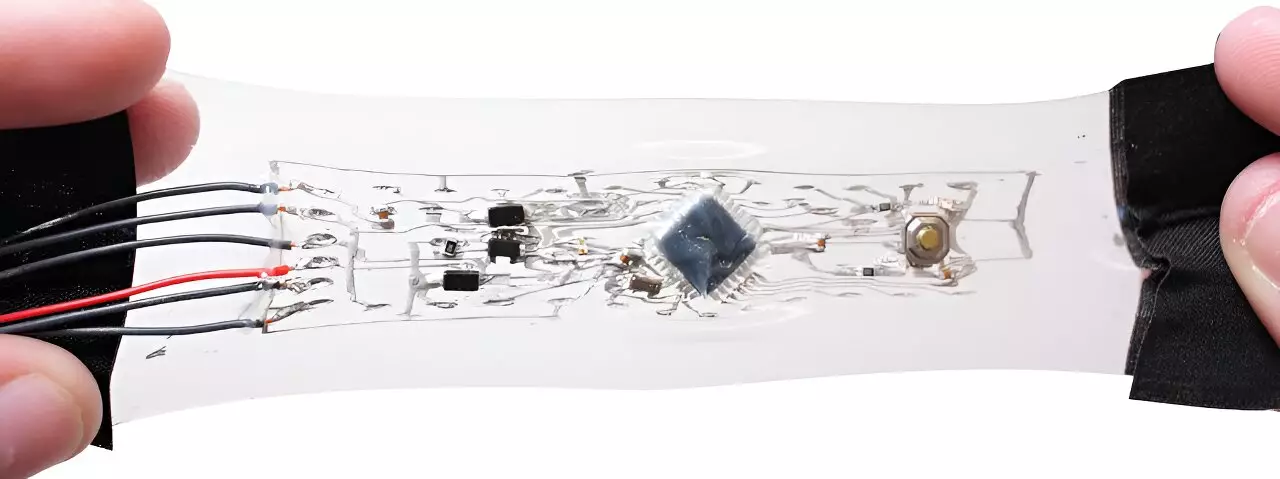In the realm of technology, the integration of soft robotics and wearable electronic devices represents a frontier filled with promise and transformative potential. From search-and-rescue missions to advanced orthopedic therapies, the applications for these innovative systems are vast. However, crafting these devices so that they are both functional and practical has proven to be a considerable challenge. Addressing this conundrum, a dedicated team in the lab of Professor Rebecca Kramer-Bottiglio has made significant strides in developing electronics that can stretch far beyond their initial dimensions, opening doors to new and diverse uses.
A prominent challenge in the field of soft robotics is effectively interfacing the rigid electronics with their softer counterparts. Typically, traditional circuitry is constructed with materials that do not bend or stretch, complicating the development of truly flexible robots. This complexity often leads to designers resorting to external circuit boards, which ultimately limits the potential functionality and responsiveness of the robots. The breakthrough achieved by Kramer-Bottiglio’s research team, as reported in *Science Robotics*, revolves around creating stretchable electronics, notably an adaptable version of Arduino, which can be embedded directly within soft robotic structures.
This innovative approach is unique in that it enables the circuitry to maintain its functionality while conforming to the dynamic movements and contortions of soft materials. By producing an electronics platform that is not just stretchable but also scalable and easy to reproduce, the research team has paved the way for the next generation of intelligent soft robots and wearable devices.
The traditional design methodology, which often relegated electronics to less critical areas of the robot’s design to avoid strain, has been fundamentally challenged by this new research. Kramer-Bottiglio’s lab intentionally placed components in high-strain areas, showcasing their enhanced durability. This strategic placement allows for greater creativity in subsequent designs, pushing against the limitations imposed by previous standards. The result is a sophisticated network of over 70 points of contact between rigid circuits and soft bodies that exhibited considerable stretchability—extending three to four times their original size without compromising functionality.
Lead author Stephanie Woodman highlights the orderly yet transformative process the team undertook. By overcoming the typical hurdles associated with manufacturing such complex circuitry, they have transitioned the field from rudimentary, one-off prototypes to sophisticated and reliable multilayered circuits, signaling a significant advancement in design quality and application versatility.
The research not only emphasizes structural integrity but also prioritizes accessibility. The team made concerted efforts to show that creating stretchable electronics does not require extensive setups or specialized knowledge in circuit design. Using a gallium-based liquid metal that can be manipulated into various forms, they developed a process whereby the material can be easily painted onto pre-cut circuit patterns. This step removed barriers to entry for those interested in exploring soft robotics or wearable technologies. Everything from the fabrication materials to the design methodologies is openly shared, encouraging further exploration and innovation in the field.
The diverse applications of these stretchable circuits are already being explored. For instance, one of their prototypes governs the gait of a four-legged robot, demonstrating full functionality while being subjected to stretching movements. Additionally, wearable devices designed for rehabilitation of injured limbs present another exciting avenue of exploration. Woodman specifically notes that the application of these circuits in challenging scenarios, such as on an elbow where substantial movement occurs, showcases their robust adaptability.
The implications of this advancement in stretchable electronics extend far beyond the laboratory. As the researchers continue to refine their prototypes and production methods, a variety of applications ranging from soft robotics to everyday wearable tech promise to revolutionize how these devices are conceived and utilized. The emergence of affordable and reliable stretchable electronics paves the way for innovative designs that were once deemed impractical.
Overall, the groundbreaking work being accomplished by Kramer-Bottiglio’s team exemplifies a crucial step in the evolution of robotics and wearable technology. By melding flexibility with robust functionality, they have undeniably advanced the vision of soft robots and elastic wearable electronics that harmonize with human movement and serve diverse needs. The future appears bright as researchers build on this solid foundation, continually pushing the boundaries of what may be possible in the fascinating intersection of electronics and soft robotics.

